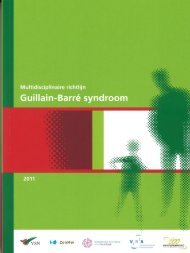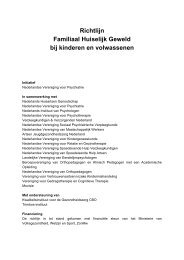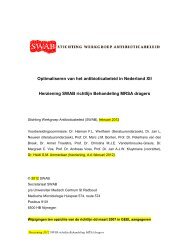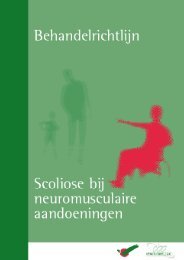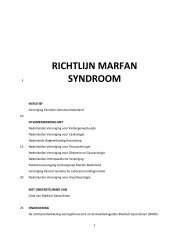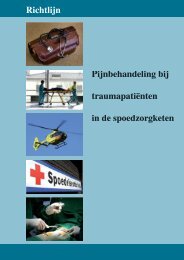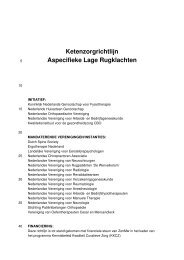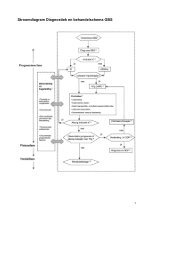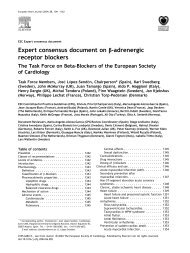Richtlijn: Otitis Externa - Kwaliteitskoepel
Richtlijn: Otitis Externa - Kwaliteitskoepel
Richtlijn: Otitis Externa - Kwaliteitskoepel
Create successful ePaper yourself
Turn your PDF publications into a flip-book with our unique Google optimized e-Paper software.
Contact sensitivity of the external auditory canal can result in refractory AOE in some patients.<br />
Delayed-type hypersensitivity reactions to topical antiseptic otic preparations are characterized by<br />
severe pruritus, skin inflammation, edema of the external auditory canal, and persistent otorrhea;<br />
blisters and vesicles may be present. The allergic reaction can extend beyond the ear canal to involve<br />
the skin around the ear and the neck. Neomycin-containing eardrops are most commonly noted to<br />
cause contact sensitivity, which has a 13% to 30% prevalence on patch testing of patients with<br />
chronic otitis externa (Sood 2002, Devos 2000, Rutka 2004). Contact sensitivity of the ear canal may<br />
also result from other topical antimicrobials (bacitracin, quinolones, gentian violet, polymyxin B<br />
sulfate), topical steroid preparations (hydrocortisone, triamcinolone), or topical anesthetics<br />
(benzocaine alone, or combined with dibucaine and tetracaine [caine mix]). Preservatives in topical<br />
otic preparations associated with at least a 1% incidence of contact sensitivity include propylene<br />
glycol, thimerosal, benzalkonium chloride, benzethonium chloride, and methyl-p-oxybenzoate (Sood<br />
2002, Devos 2000, Rutka 2004).<br />
Dermatose<br />
Eczema, seborrhea, and other inflammatory dermatoses that involve the ear canal and surrounding<br />
tissues are relatively common and may predispose to acute infection.<br />
Furunculosis<br />
Furunculosis is the presence of an infected hair follicle on the outer third of the ear canal, sometimes<br />
referred to as localized otitis externa. Clinical findings include otalgia, otorrhea, and localized<br />
tenderness. Treatment may include local heat, incision and drainage, or systemic antibiotics that<br />
cover S aureus, the most common causative agent.<br />
Viral infections<br />
Viral infections of the external ear, caused by varicella, measles, or herpesvirus, are rare. Herpes<br />
zoster oticus (Ramsay Hunt syndrome) causes vesicles on the external ear canal and posterior surface<br />
of the auricle, severe otalgia, facial paralysis or paresis, loss of taste on the anterior two-thirds of the<br />
tongue, and decreased lacrimation on the involved side (Kuhweide 2002). Management involves<br />
antiviral therapy, with or without systemic steroid.<br />
Conclusie<br />
Level of Evidence 3<br />
Observational studies<br />
Elements of the diagnosis of diffuse acute otitis externa<br />
1. Rapid onset (generally within 48 hours) in the past 3 weeks<br />
AND<br />
2. Symptoms of ear canal inflammation that include:<br />
• otalgia (often severe), itching, or fullness,<br />
• WITH OR WITHOUT hearing loss or jaw pain*<br />
AND<br />
3. Signs of ear canal inflammation that include:<br />
• tenderness of the tragus, pinna, or both<br />
• OR diffuse ear canal edema, erythema, or both<br />
• WITH OR WITHOUT otorrhea, regional lymphadenitis,<br />
tympanic membrane erythema, or cellulitis of the pinna and<br />
adjacent skin<br />
*Pain in the ear canal and temporomandibular joint region intensified by jaw motion.<br />
14 <strong>Richtlijn</strong> <strong>Otitis</strong> <strong>Externa</strong> 2010<br />
Nederlandse Vereniging voor Keel-Neus-Oorheelkunde en Heelkunde van het Hoofd-Halsgebied




